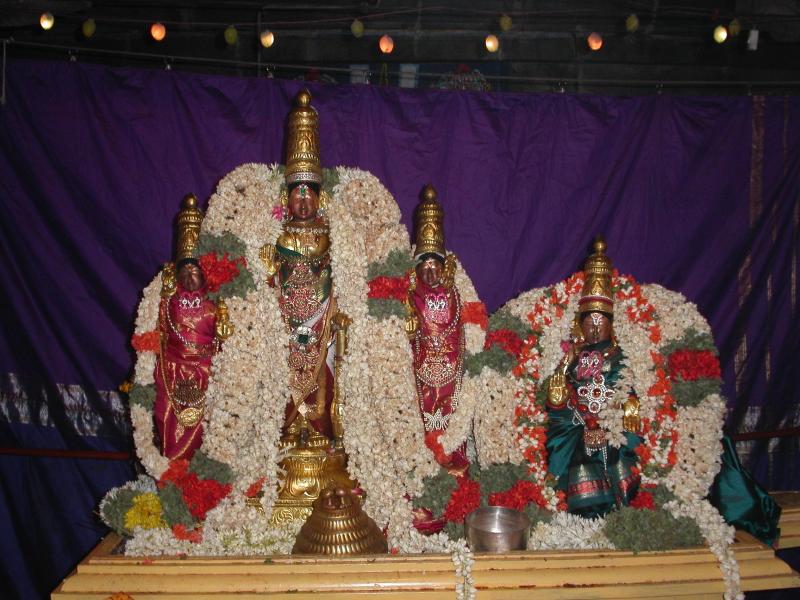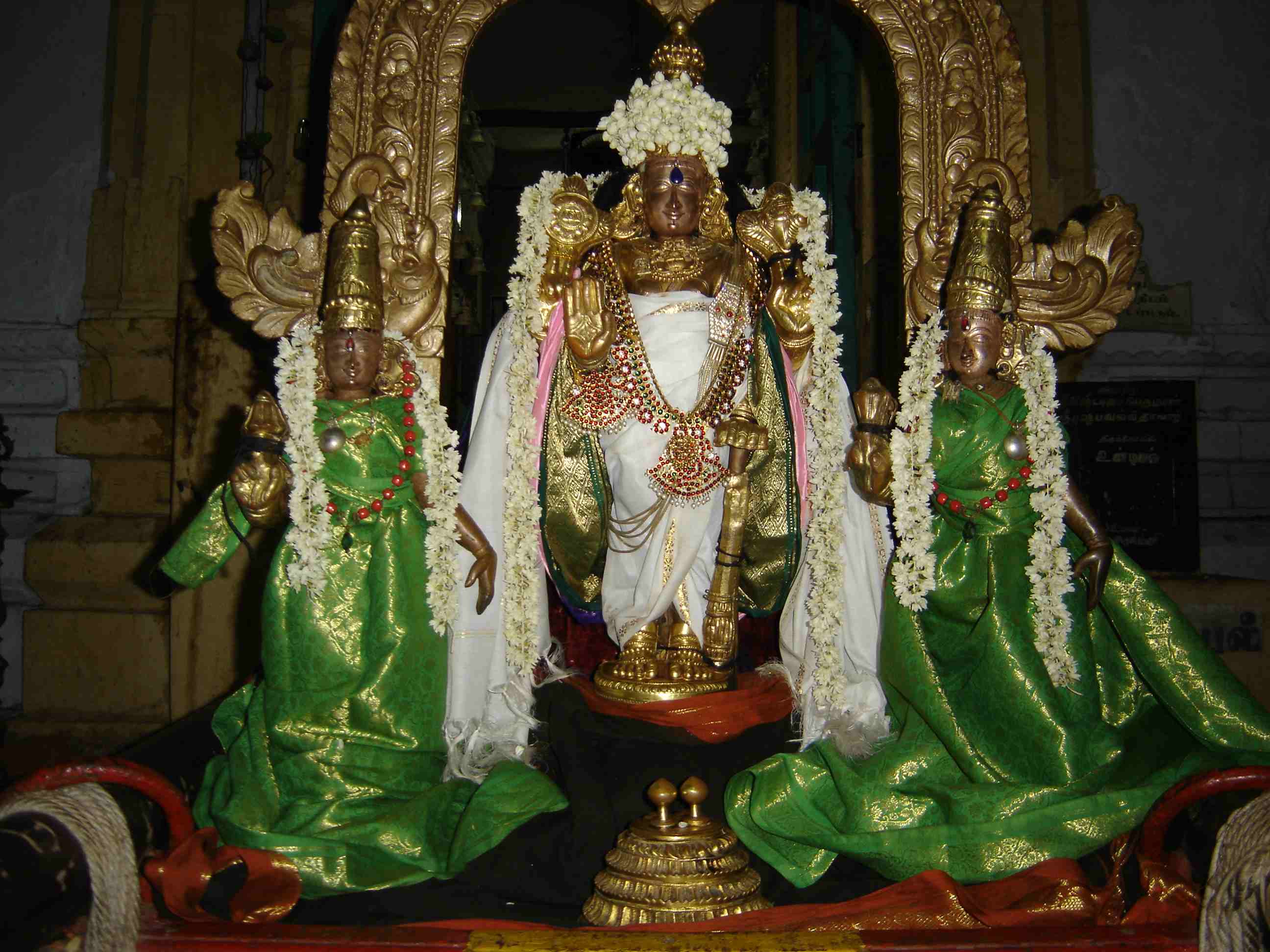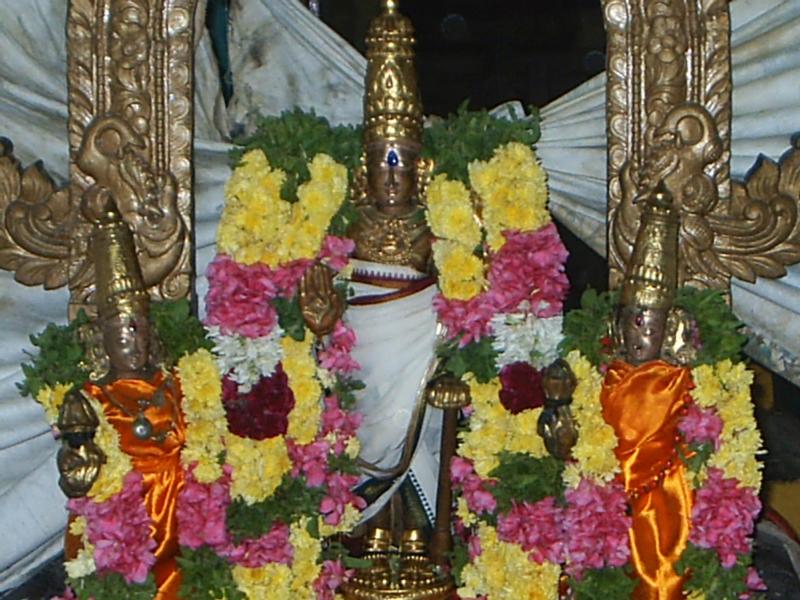
In earlier days the Lord was called Sri Adivaraha Perumal [ஸ்ரீ ஆதி வராஹ பெருமாள்]. Sri Thayar is Sri Anjalaivalli Nacchiyar [ஸ்ரீ அஞ்சலைவல்லி நாச்சியார்]. Pushkarini is Nitya pushkarini [நித்ய புஷ்கரிணி ]. Vimanam is Vamana vimanam [வாமன விமானம் ]. The Lord appeared for Asvatta Narayana. Swami Periyavacchan Pillai says that the Lord is Sri Kalvan, because He is hiding Himself in an obscure place and not revealing to the pleasure of all! Pujas are performed to the Lord. Right lower arm is in abhaya mudra, while the left arm is on His left lap, indicating that He would rescue us by reducing the samsara ocean to knee deep level. At present neither the Vamana vimanam nor the Nitya pushkarini is available for viewing; but the Lord and Sri Thayar are gracing. Sri Thayar is with folded hands. Though Sri Thayar is imageless, the kumkum [குங்குமம்] distributed here is presumed to be obtained from Sri Thayar. We should worship the Lord without deceit. Should we worship Him or not? Is there God or not? Who is sustaining all of us? Going with such doubts, is the deceit we possess. Going secretly and alone to worship also is another deceit. We have to worship the Lord with everybody. His deceit is not revealing Himself to His devotees. Swami Pillai Perumal Iyengar has composed a pasuram on this Kshetram in his 'Nootrettu Thiruppathi Andhadi [நூற்றெட்டு திருப்பதி அந்தாதி]'. He says that though our soul is servant to the Lord from long ago, yet we assumed that the soul was ours and that we were independent not servant to anyone. That is, we considered His property - soul - as ours. So, who is kalva [thief]? Are we not the kalvas? asks the author. But unfortunately, the Lord is called Sri Kalva, pities Swami Pillai Perumal Iyengar. But the Lord in Chapter 11 has no such deceit and He agreed to show His Viswaroopam at the request of Arjuna. We are to see sloka 47, from which the Lord speaks. Till sloka 46 Arjuna described what he saw, how he respected and was delighted and finally requested the Lord to reduce His image to the usual one. For that the Lord replies in the next Three slokas starting from sloka 47:
sri-bhagavan uvaca
maya prasannena tavarjunedam
rupam param darshitam atma-yogat
tejo-mayam vishvam anantam adyam
yan me tvad anyena na drsta-purvam
"The Supreme Personality of Godhead said: My dear Arjuna, happily have I shown you, by My internal potency, this supreme universal form within the material world. No one before you has ever seen this primal form, unlimited and full of glaring effulgence."
The Lord pacifies Arjuna. Darshitam = showing [Viswaroopam ], tava = to you [Arjuna], prasannena = happily, maya = by Me [Sri Krishna], atma-yogat = with My [Sri Krishna's] sankalpam or will power. The Lord decides or resolves to grant a person a thing or His darshan. His resolution or will is atma-yogam. This is His sankalpam. We also resolve to do certain things; but we are not sure whether all would be carried out. Many obstacles might impede such resolutions. While, when the Lord resolves, there are no obstacles whatsoever. In this only, we also should try to come nearer God. In our case, out of Ten resolutions Eight are failures and only Two might get completed. But, when the Lord resolves it is 100% success. Why are yogam, bhakti, shastras, sampradhayam, etc., mentioned? Those are to progress us from making our sucess in our resolutions, say from 20% to higher. We can never be successful in 100%, as we are not God; but, we can appraoch near His level. Yogis and Alwars are great because they choose what to decide and mostly all of them are carried out. This is because of Bhakti and the feeling of servitude to the Lord. These themselves would take us near Him. By His resolution, Arjuna got to view His, param roopam = most supreme Image. That is His Viswaroopam was shown . How did Arjuna view that image? Tejo mayam = full of brightness [possessed by various things in this Universe]. Normally, what is predominant is expressed. If we say golden ring, even though it might be an alloy of gold and copper, the predominant gold is used to describe. But here by saying tejo mayam, it does not mean that the Lord's image had some dark patches and predominantly bright; the image was absolutely full of brightness alone. Vishvam = pervading everywhere in the Universe. Arjuna was able to see everything in this Universe, in His Viswaroopam Image. Ananta = unlimited image. The Image he saw was not limited by time, by place, by matter, by image or by anything. Anantam also means that without beginning or end or middle. Adyam = Prime Cause. He is the Creator, Sustainer and Destroyer. He is the Origin for everything. Anyena = others, na drushta = had not seen, poorvam = earlier. Arjuna got this rare view because the Lord decided so. The Lord thus explained the greatness of the Viswaroopam and indicated His decision to get back to His usual form. We may have a doubt here. Is it that the Lor is full of brightness only in Viswaroopam and not in His usual form? Is He infinite and unlimited only in Viswaroopam? Though the Lord comes back to His usual form of Sri Krishna, by no means His greatness and eminence get diminished. We see the Lord as a small idol in temple. It is not correct to think that His power and greatness is infinite only in Viswaroopam and not in the idol in temple. This, the Lord has explained in Chapter 4 itself. In 4.6 the Lord said that whatever form He took, be it a worm or animal, His greatness and Powers were never less. There is no compromise on His greatness according to the form He took. His greatness like full of brightness or infinity or being the Origin of all, continue even when He is a Chariot Driver or a Messenger or a Boar or a Tortoise. Then why does He reduce Himself to such forms? That is another greatness of His quality of soulabhyam or simplicity. With this quality He is available for our view. One, who thinks that those simple forms of the Lord could not have the same greatness, loses Bhakti and one tends to be nastika. We have to understand that the Lord graced us, not because of our efforts, but because of His sankalpam. Since the Lord has used the words prasannena [His delight] and atma-yogam [His sankalpam], we have strive for His happiness so that He decided to bless us. With this we take leave of Thirukkalvanur, and having visited all the Kshetrams in Kanchi mandalam, we will now proceed to other Kshetrams in Thondai Nadu.













